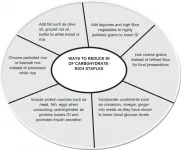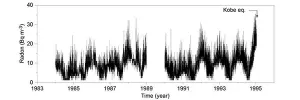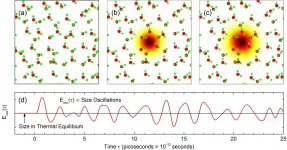Preventing injuries and improving recovery with micro-Doppler radars
2021-03-04
(Press-News.org) ?Micro-Doppler radars could soon be used in clinical settings to predict injury risk and track recovery progress, according to Penn State researchers.?
Being able to view subtle differences in human movement?would allow health care workers to more accurately identify individuals who may be at risk for injury and to track progress precisely while individuals are recovering from an injury. In an effort to find an accurate, reliable and cost-effective way to measure these subtleties ?in human movement, College of Engineering and College of Medicine researchers teamed up to develop a radar in front of which athlete study-subjects could jump.??
"My students and I designed and constructed the radar system to characterize the micro-Doppler features of human gait, developed and tested various classification algorithms to separate patterns from different gait types and validated our hypothesis using measured data from athletes mimicking different gait patterns,"?said Ram Narayanan, professor of electrical engineering in the School of Electrical Engineering and Computer Science.??
The radar system relies on the Doppler?effect?-- a way of measuring the change in wave frequency between a target and an observer -- to provide precise information about the movements of that target, in this case, the athlete. This radar system could be a cost-effective, portable and scalable alternative to motion capture systems, which are currently the most accurate system for showing subtle movements. However, they are too expensive, large and time-intensive with use to be a viable option in most situations.?
"The micro-Doppler radar has not been used in health care to this point and is a novel way to look at human movement," said Dr.? Cayce? Onks,?associate professor of family and community medicine and of orthopedics and rehabilitation in the College of Medicine, and physician at Penn State Health.?"Our publication is the first of its kind evaluating the accuracy and predictability of the radar."?
The results were published in the journal Gait and Posture.?
The study had NCAA athletes jump in front of the radar barefoot, wearing shoes, and wearing shoes with?a heel lift.?The radar was able to classify the jumps into each of those three categories with greater than 90% accuracy, something that existing motion-capture systems cannot accomplish, according to Onks.
"The findings of our study show that the micro-Doppler radar is able to?'see' differences in human movement that the human eye is not able to differentiate," Onks?said. "This type of information has the potential to be applied to hundreds of clinical applications, including but not limited to prevention of falls and disabilities, early detection of Parkinson's, early detection of dementia, concussion diagnosis and identification of movement patterns that place individuals at risk for any number of musculoskeletal injuries, such as ankle injuries and ACL tears.?Other applications may include determining readiness of an individual to return to movement following rehabilitation from an injury or surgery."?
INFORMATION:
In order to further explore these possible applications, the researchers plan to apply for additional funding through the National Science Foundation and the National Institutes of Health.
Other researchers on this project include Donald Hall and Tyler Ridder, both research and development engineers in Penn State's Applied Research Laboratory; Zacharie?Idriss, doctoral student in the Department of Electrical Engineering; and??Joseph Andrie, assistant professor of family and community medicine and of orthopedics and rehabilitation in the College of Medicine and a physician at Penn State Health.??
This Department of Family and Community Medicine at Penn State College of Medicine funded this research.
ELSE PRESS RELEASES FROM THIS DATE:
2021-03-04
Professor Christiani Jeyakumar Henry, Senior Advisor of Singapore Institute of Food and Biotechnology Innovation (SIFBI), Agency for Science, Technology and Research (A*STAR) and his team have developed a Glycaemic Index (GI) glossary of non-Western foods. The research paper was published in Nutrition & Diabetes on 6 Jan 2021: https://doi.org/10.1038/s41387-020-00145-w.
Observational studies have shown that the consumption of low glycaemic index (GI) foods is associated with a lower risk of type 2 diabetes mellitus (T2DM), significantly less insulin resistance and a lower prevalence of the metabolic syndrome. However, most published GI values focus on Western foods with minimal inclusion of other foods from non-Western countries, hence their application ...
2021-03-04
Tohoku University researchers have unearthed further details about radon concentration in the atmosphere before and after earthquakes, moving us closer to being able to anticipate when large earthquakes may hit.
The results of their research were published in the journal Science Reports on February 18, 2021.
Radon is a radioactive noble gas derived from radioactive decays of radium-226 in the ground. Radon bubbles up to the surface and is expelled into the atmosphere.
It has long been known that elevated levels of radon underneath the ground can be detected before and after earthquakes. But the relationship between the mechanisms that cause abnormal changes in radon concentration and the occurrence of earthquakes requires greater ...
2021-03-04
Interspecies interactions are the foundation of ecosystems, from soil to ocean to human gut. Among the many different types of interactions, syntrophy is a particularly important and mutually beneficial interspecies interaction where one partner provides a chemical or nutrient that is consumed by the other in exchange for a reward.
Syntrophy plays an essential role in global carbon cycles by mediating the conversion of organic matter to methane, which is about 30 times more potent than carbon dioxide as a greenhouse gas and is a source of sustainable energy. And in the human gut, trillions of microbial cells also interact ...
2021-03-04
Intelligent holographic nanostructures on CMOS sensors for energy-efficient AI security schemes
Today, machine learning permeates our everyday life, with millions of users every day unlocking their phones through facial recognition or passing through AI-enabled automated security checks at airports and train stations. These tasks are possible thanks to sensors that collect optical information to feed it to a neural network in a computer. Imagine to empower the sensors in the devices you use every day to perform artificial intelligence functions without a computer - as simply as putting glasses on them.
The integrated holographic perceptrons developed by a research team at University of Shanghai for Science and Technology led ...
2021-03-04
Nairobi/Paris, 4 March 2021 - An estimated 931 million tonnes of food, or 17% of total food available to consumers in 2019, went into the waste bins of households, retailers, restaurants and other food services, according to new UN research conducted to support global efforts to halve food waste by 2030.
The weight roughly equals that of 23 million fully-loaded 40-tonne trucks -- enough bumper-to-bumper to circle the Earth 7 times.
The Food Waste Index Report 2021, from the United Nations Environment Programme (UNEP) and partner organization WRAP, looks at food waste that occurs in retail outlets, restaurants and homes - ...
2021-03-04
People with higher incomes tend to feel prouder, more confident and less afraid than people with lower incomes, but not necessarily more compassionate or loving, according to research published by the American Psychological Association.
In a study of data from 162 countries, researchers found consistent evidence that higher income predicts whether people feel more positive "self-regard emotions," including confidence, pride and determination. Lower income had the opposite effect, and predicted negative self-regard emotions, such as sadness, fear and shame. The research was published online in the journal Emotion. ...
2021-03-04
A group of researchers, spanning six universities and three continents, are sounding the alarm on a topic not often discussed in the context of conservation--misinformation.
In a recent study published in FACETS, the team, including Dr. Adam Ford, Canada Research Chair in Wildlife Restoration Ecology, and Dr. Clayton Lamb, Liber Ero Fellow, both based in the Irving K. Barber Faculty of Science, explain how the actions of some scientists, advocacy groups and the public are eroding efforts to conserve biodiversity.
"Outcomes, not intentions, should be the basis for how we view success in conservation," says Dr. Ford.
"Misinformation related to vaccines, climate change, and links between smoking ...
2021-03-04
Ionization of water molecules by light generates free electrons in liquid water. After generation, the so-called solvated electron is formed, a localized electron surrounded by a shell of water molecules. In the ultrafast localization process, the electron and its water shell display strong oscillations, giving rise to terahertz emission for tens of picoseconds.
Ionization of atoms and molecules by light is a basic physical process generating a negatively charged free electron and a positively charged parent ion. If one ionizes liquid water, the free electron undergoes a sequence of ultrafast processes by which it loses energy and eventually localizes at a new site in ...
2021-03-04
CHAPEL HILL, North Carolina--UNC Lineberger Comprehensive Cancer Center researchers have successfully used an experimental safety switch, incorporated as part of a chimeric antigen receptor T-cell (CAR-T) therapy, a type of immunotherapy, to reduce the severity of treatment side effects that sometimes occur. This advance was seen in a patient enrolled in a clinical trial using CAR-T to treat refractory acute B-cell leukemia. It demonstrates a proof-of-principle for possible expanded use of CAR-T immunotherapy paired with the safety switch.
The researchers published their findings in the journal Blood as an ahead-of-print publication.
With CAR-T therapy, T-cells from a patient's immune system ...
2021-03-04
The human genome contains roughly three million letters. On average, the genome sequences of any two people differ from each other by about one in every 1,000 letters. Yet different variants occur, from substituted letters to entire missing sections of DNA. Scientists from the Berlin Institute of Health (BIH) and the Regensburg Center for Interventional Immunology (RCI) have teamed up with Icelandic researchers to develop software that reliably and quickly identifies large deletions in ten-thousands of genomes simultaneously. The researchers have now published their findings in the journal Nature Communications.
The human genome contains roughly three million letters ...
LAST 30 PRESS RELEASES:
[Press-News.org] Preventing injuries and improving recovery with micro-Doppler radars




